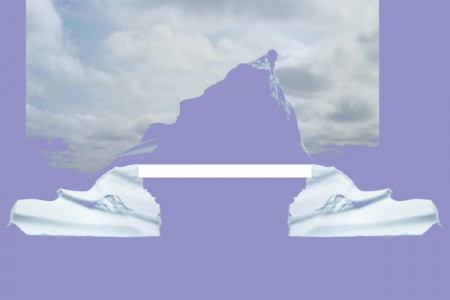Entry 182 — “Dash No. 1,” by Koppany
This is one of the three pieces Marton Koppany sent me recently. I’m posting it now (1) to take care of another entry with minimum effort, (2) because I like it a lot, and (3) to allow me to babble a bit more on my favorite topic, What Visual Poetry Is.
As those who know my work as a critic, I contend that a text cannot be a poem unless it has words that are of significant importance to what the text does aesthetically. This piece contains no words, as most people understand the term. Nonetheless, I’m prepared to claim it to be a poem. Clearly, this piece is on what I call the borblur–the borderline between conceptual visimagery and visual poetry. I call it the later because I believe all punctuation marks (and similar symbols such as those used in chemistry or mathematics) can act as words in certain unusual situations.
Specifically, when a punctuation mark in a work is sufficiently emphasized to make it difficult for someone “reading” the work to treat it as nothing more than a punctuation mark, it will become a word. That is, it will not be skimmed through with little or no conscious notice–actually, with no vaonscous verbal notice, as with the dash I just used–but pondered consciously, possibly even indentified consciously as what it is, it will become a word. It will denote as well as, or even perhap instead of, acting purely punctuationally. In the case of the work above, I claim most people–at least most people familiar with the territory–will read the dash in it (even without the title of the piece), as “dash, short-cut,” then realize sensorily how it is making something rather large disappear, or realize how it works. A simple but unexpected metaphor visualized.
The pun in English of “dash” as a verb meaning to go in a hurry is a very nice extra, entirely verbal extra.
Note: my only problem with the piece is its title, which I think too overt. I’d prefer something more like “Punctuation Poem No. 63, or the like. “Mountain subjected to Punctuation?” No, but something like that, but more intelligent. . . .

Thank you so much, Bob! I’m VERY glad you liked it and I’m grateful for your attention! The title serves only to slow the reading down in this case. It may be too overt, I’m not sure.
what id like to know is what are the 2 pieces on each side of the dash. mirror images of torn paper? or are they 2 items that give a base to the top “mountain” piece? and does the “mountain contain within it – a dash? or does the dash signify the name of the “mountain. i like it and i like what you wrote, bob. marton, youre making work that’s moving in another direction – always a good thing. i always enjoy seeing, thinking about it.
Thank you so much for your words, Nico! (I’ve just come home from vacation and read your comment.) The two pieces on the two sides of the dash are identical: they’re the image of an iceberg, taken from the internet. I’d had a certain idea, and needed an iceberg for it. But I hadn’t guessed beforehand that they would look like a pair of shoes. I’m always in a dialogue with the “material”. This time the “material” really surprised me, and it took the initiative. The second surprise came from
“Magic Wand” (of a simple image editor software). I wanted to insert a piece of mountain-like negative space (made of sky) between the two icebergs, but I did something wrong, and had to realize that the edges of the sky are “thawing” – in complete synchrony with the icebergs. (My original idea got an extra confirmation, which was stronger than mine.) I didn’t touch the image from that point on. DASH is the base of a mountain-like (and already thawing) negative space between two disappearing icebergs which are identical with each other. And the shoes belong together, and the negative space is their wearer. There’s no separate place or time for the thought “between” the two other thoughts. They “happen” at the very same moment and belong together.
Or something like that.